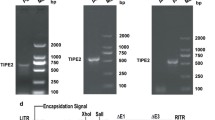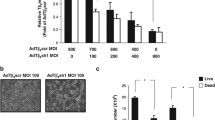Abstract
Aberrant activation of Signal Transducer and Activator of Transcription 3 (STAT3) signaling has been shown to be associated with uncontrolled cell proliferation and suppression of host-immune surveillance. Conversely, silencing STAT3 can have the dual effects of inhibiting cancer cell proliferation and inducing anti-tumor immune responses. Here, we report on the effects of STAT3 silencing on suicide gene therapy with thymidine kinase (tk). STAT3 silencing by siRNA inhibited the proliferation of AGS human gastric cancer cells through G1 cell cycle arrest, decreased levels of immune-suppressive cytokines, and increased levels of immune-activating cytokines. CT26 mouse colon adenocarcinoma cells, in which STAT3 expression was knocked-down by a STAT3 shRNA-containing lentivirus, grew more slowly in syngenic model Balb/c mice than control CT26 cells. Moreover, we found that STAT3 silencing augmented the efficacy of suicide gene therapy in CT26 cell xenografted mice. When we administrated adenoviruses harboring the herpes simplex virus thymidine kinase gene (Ad5.CMV.HSV.tk) into STAT3-silenced CT26 cell tumors, extensive apoptosis was observed and there was a significant reduction in the size of CT26 cell tumors. STAT3 silencing also enhanced the recruitment and cytotoxic activity of CD3+CD8+ T-cells, and changed the cytokine expression pattern of CT26 cell tumors, reflecting augmentation of anti-cancer immune responses. We conclude that combining suicide gene therapy with STAT3 silencing can result in enhanced anti-cancer effects.






Similar content being viewed by others
Abbreviations
- GCV:
-
Ganciclovir
- HSV.tk:
-
Herpes simplex virus thymidine kinase
- STAT3:
-
Signal Transducer and Activator of Transcription-3
- 7-AAD:
-
7-Aminoactinomycin D
- PE:
-
Phycoerythrin
- MOI:
-
Multiplicity of infection
References
Gao H, Ward PA (2007) STAT3 and suppressor of cytokine signaling 3: potential targets in lung inflammatory responses. Expert Opin Ther Targets 11:869–880
Brantley EC, Benveniste EN (2008) Signal transducer and activator of transcription-3: a molecular hub for signaling pathways in gliomas. Mol Cancer Res 6:675–684
Jackson CB, Giraud AS (2009) STAT3 as a prognostic marker in human gastric cancer. J Gastroenterol Hepatol 24:505–507
Turkson J, Jove R (2000) STAT proteins: novel molecular targets for cancer drug discovery. Oncogene 19:6613–6626
Oka M, Sakaguchi M, Okada T, Nagai H, Ozaki M, et al. (2010) Signal transducer and activator of transcription 3 upregulates interleukin-8 expression at the level of transcription in human melanoma cells. Exp Dermatol 19(8):e50–5
Fitzgerald JS, Busch S, Wengenmayer T, Foerster K, de la Motte T et al (2005) Signal transduction in trophoblast invasion. Chem Immunol Allergy 88:181–199
Huang S (2007) Regulation of metastases by signal transducer and activator of transcription 3 signaling pathway: clinical implications. Clin Cancer Res 13:1362–1366
Kusaba T, Nakayama T, Yamazumi K, Yakata Y, Yoshizaki A et al (2006) Activation of STAT3 is a marker of poor prognosis in human colorectal cancer. Oncol Rep 15:1445–1451
Ito N, Eto M, Nakamura E, Takahashi A, Tsukamoto T et al (2007) STAT3 polymorphism predicts interferon-alfa response in patients with metastatic renal cell carcinoma. J Clin Oncol 25:2785–2791
Kortylewski M, Kujawski M, Wang T, Wei S, Zhang S et al (2005) Inhibiting Stat3 signaling in the hematopoietic system elicits multicomponent antitumor immunity. Nat Med 11:1314–1321
Kortylewski M, Yu H (2007) Stat3 as a potential target for cancer immunotherapy. J Immunother 30:131–139
Kortylewski M, Yu H (2008) Role of Stat3 in suppressing anti-tumor immunity. Curr Opin Immunol 20:228–233
Gariboldi MB, Ravizza R, Molteni R, Osella D, Gabano E et al (2007) Inhibition of Stat3 increases doxorubicin sensitivity in a human metastatic breast cancer cell line. Cancer Lett 258:181–188
Minegishi Y, Saito M, Tsuchiya S, Tsuge I, Takada H et al (2007) Dominant-negative mutations in the DNA-binding domain of STAT3 cause hyper-IgE syndrome. Nature 448:1058–1062
Lewis HD, Winter A, Murphy TF, Tripathi S, Pandey VN et al (2008) STAT3 inhibition in prostate and pancreatic cancer lines by STAT3 binding sequence oligonucleotides: differential activity between 5′ and 3′ ends. Mol Cancer Ther 7:1543–1550
Li WC, Ye SL, Sun RX, Liu YK, Tang ZY et al (2006) Inhibition of growth and metastasis of human hepatocellular carcinoma by antisense oligonucleotide targeting signal transducer and activator of transcription 3. Clin Cancer Res 12:7140–7148
Kim SJ, Choi IJ, Cheong TC, Lee SJ, Lotan R et al (2010) Galectin-3 increases gastric cancer cell motility by up-regulating fascin-1 expression. Gastroenterology 138(1035–1045):e1031–e1032
Cheong TC, Shin JY, Chun KH (2010) Silencing of galectin-3 changes the gene expression and augments the sensitivity of gastric cancer cells to chemotherapeutic agents. Cancer Sci 101:94–102
Kim SJ, Oh JS, Shin JY, Lee KD, Sung KW et al (2011) Development of microRNA-145 for therapeutic application in breast cancer. J Control Release 155:427–434
Park JS, Kim HS, Park MY, Kim CH, Chung YJ et al (2010) Topoisomerase II alpha as a universal tumor antigen: antitumor immunity in murine tumor models and H-2K(b)-restricted T cell epitope. Cancer Immunol Immunother 59:747–757
Arici DS, Tuncer E, Ozer H, Simek G, Koyuncu A (2009) Expression of retinoblastoma and cyclin D1 in gastric carcinoma. Neoplasma 56:63–67
Zushi S, Shinomura Y, Kiyohara T, Miyazaki Y, Kondo S et al (1998) STAT3 mediates the survival signal in oncogenic ras-transfected intestinal epithelial cells. Int J Cancer 78:326–330
Lau CK, Yang ZF, Lam SP, Lam CT, Ngai P et al (2007) Inhibition of Stat3 activity by YC-1 enhances chemo-sensitivity in hepatocellular carcinoma. Cancer Biol Ther 6:1900–1907
Niu G, Heller R, Catlett-Falcone R, Coppola D, Jaroszeski M et al (1999) Gene therapy with dominant-negative Stat3 suppresses growth of the murine melanoma B16 tumor in vivo. Cancer Res 59:5059–5063
Niu G, Wright KL, Huang M, Song L, Haura E et al (2002) Constitutive Stat3 activity up-regulates VEGF expression and tumor angiogenesis. Oncogene 21:2000–2008
Vile RG, Castleden S, Marshall J, Camplejohn R, Upton C et al (1997) Generation of an anti-tumour immune response in a non-immunogenic tumour: HSVtk killing in vivo stimulates a mononuclear cell infiltrate and a Th1-like profile of intratumoural cytokine expression. Int J Cancer 71:267–274
Mizuguchi H, Hayakawa T (2002) Enhanced antitumor effect and reduced vector dissemination with fiber-modified adenovirus vectors expressing herpes simplex virus thymidine kinase. Cancer Gene Ther 9:236–242
Suzuki T, Sakurai F, Nakamura S, Kouyama E, Kawabata K et al (2008) miR-122a-regulated expression of a suicide gene prevents hepatotoxicity without altering antitumor effects in suicide gene therapy. Mol Ther 16:1719–1726
Littlejohn JE, Cao X, Miller SD, Ozvaran MK, Jupiter D et al (2008) Bcl-xL antisense oligonucleotide and cisplatin combination therapy extends survival in SCID mice with established mesothelioma xenografts. Int J Cancer 123:202–208
Acknowledgments
We thank Ki-Youl Han for technical support. This study was supported by a grant from the National Cancer Center of Republic of Korea (#NCC-0910150) and a grant from the Basic Science Research Program (2010-1031790) through the National Research Foundation (NRF) funded by the Ministry of Education, Science, and Technology, Republic of Korea.
Author information
Authors and Affiliations
Corresponding author
Electronic supplementary material
Below is the link to the electronic supplementary material.
Supplementary Fig. 1
Sequences and effects of STAT3-specific siRNAs. STAT3 siRNA sequences are shown in table (a) and decreased expression of STAT3 and its downstream target cyclin D1 after STAT3 specific-siRNA treatment are shown in (b) (TIFF 73 kb)
Supplementary Fig. 2
Lentiviral STAT3 shRNA construct. Two primers for STAT3 shRNA were annealed and inserted into the pLL3.7 vector to produce a lentivirus capable of inhibiting both human and mice STAT3 expression by expression of STAT3-specific shRNA (TIFF 84 kb)
Supplementary Fig. 3
Genes regulated by inhibition of STAT3 expression in CT26 mouse colon cancer cells. CT26 cells were harvested after treatment with the indicated siRNAs and RT-PCR analysis revealed a decreased STAT3 expression, b up-regulated expression of pro-inflammatory immune response-related genes and c down-regulated expression of anti-inflammatory immune response-related genes. Beta-actin was used as a loading control (TIFF 87 kb)
Supplementary Fig. 4
Ad5.CMV.HSV.tk adenoviral construct (TIFF 59 kb)
Supplementary Table 1
Sequences of primers used for quantitative PCR (Fig. 6c) (TIFF 65 kb)
Rights and permissions
About this article
Cite this article
Ahn, YH., Yi, H., Shin, JY. et al. STAT3 silencing enhances the efficacy of the HSV.tk suicide gene in gastrointestinal cancer therapy. Clin Exp Metastasis 29, 359–369 (2012). https://doi.org/10.1007/s10585-012-9458-4
Received:
Accepted:
Published:
Issue Date:
DOI: https://doi.org/10.1007/s10585-012-9458-4




